The post A Jaws-Dropping Encounter in Gansbaai appeared first on The Expeditioner Travel Site.
]]>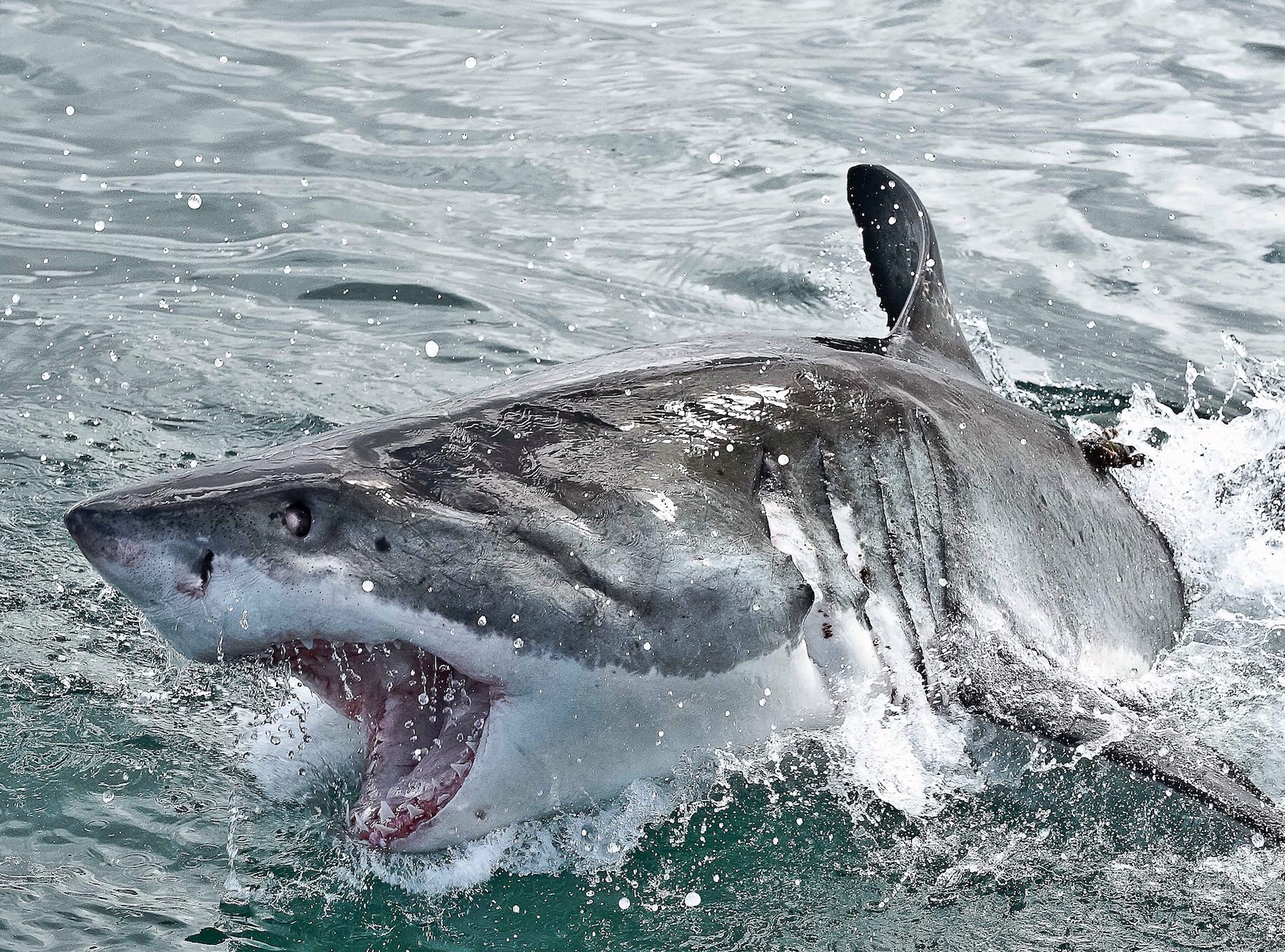
Ten minutes into the boat ride toward Dyer Island, across the schizophrenic waters off Gansbaai where the Atlantic and Indian Oceans collide, I realized the most menacing creature encountered while shark cage diving isn’t below the water, it’s above it. Dozens of seagulls fluttered and squawked as their droppings smacked down like a hailstorm.
You’re gonna need a broader hat.
Shark cage diving is one of South Africa’s most popular activities for travelers. Known as South Africa’s unofficial cage diving epicenter, the infamous “Shark Alley” stretch off the coast of Gansbaai, about two hours southeast of Cape Town. Shark Alley became world-renowned due to its recurring role on Discovery Channel’s annual Shark Week extravaganza — which recently celebrated its 30th anniversary this summer — and a big reason why cage diving sits alongside safaris on most travelers’ South African bucket lists.
“The cage diving industry has gone from strength to strength,” said Chris Fallows, owner of Apex Shark Expeditions. “The need to deliver a polished, educational and professional product in a competitive environment has led to several companies ticking all these boxes.”
Fallows is one of the key players in the cage diving industry that serves in excess of 100,000 people each year within South Africa. He is the first person to ever photograph breaching great whites and the creative force behind Air Jaws: Sharks of South Africa, the high-flying 2001 documentary that aired during Shark Week and introduced the world to the acrobatic predators. Fallows’ Apex Shark Expeditions handles 2,000 clients each year and emphasizes a small (12 clients maximum per boat), personalized approach to cage diving as travelers look to live out a Shark Week-esque experience.
“I think the general population is rapidly starting to look at sharks in a very respectful and positive light,” Fallows said. “Great whites are incredible, majestic, and powerful predators and it is a privilege to have them off our coast.”
Apex is one of a dozen cage diving operators in the Cape Town area. Depending on the operator, cage diving costs between $130 — $200 for a half-day excursion and includes transportation to Gansbaai from Cape Town.
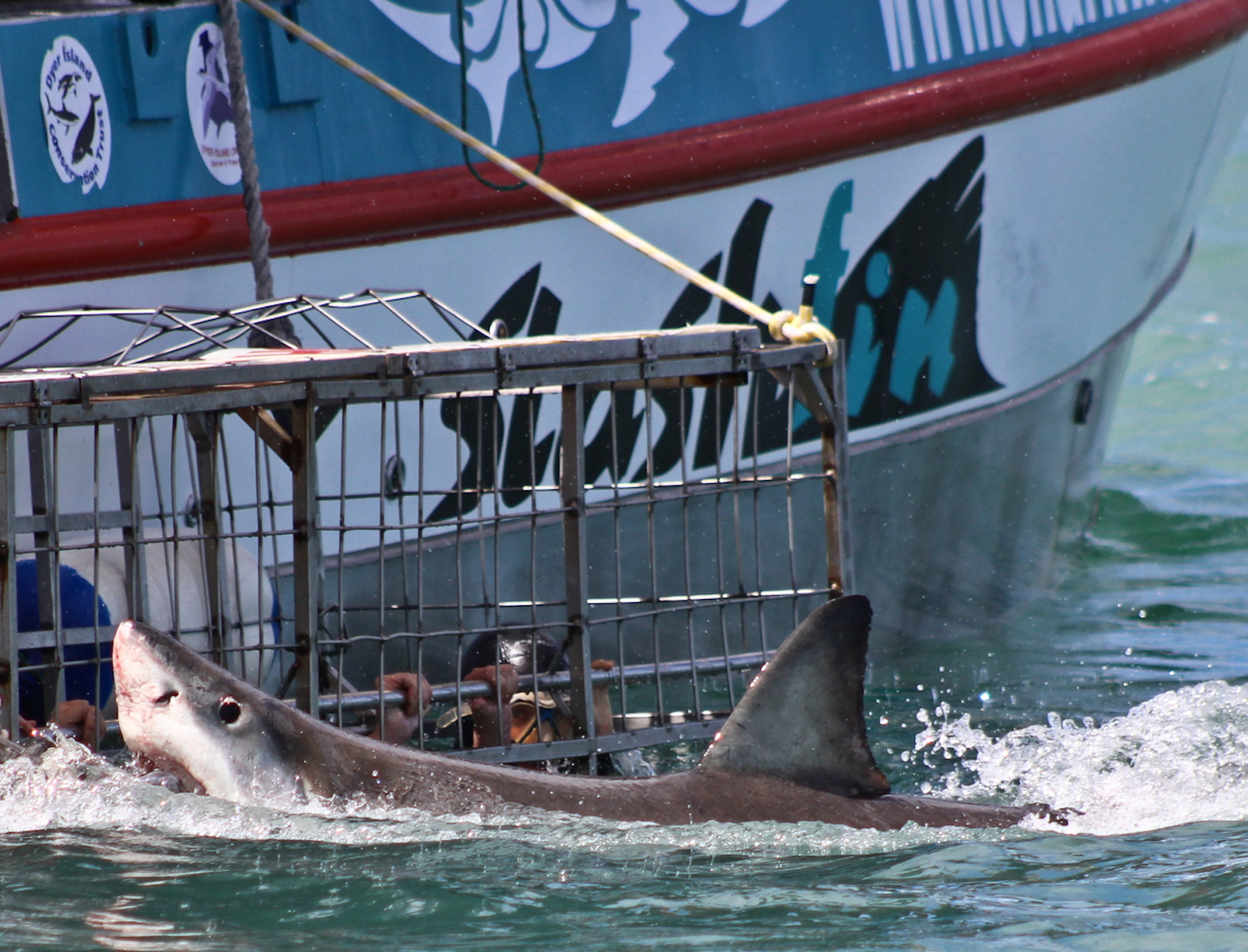
“Cage diving is one of the few wildlife experiences where people can see the creatures in their actual ecosystem,” said Alison Towner, a biologist with Marine Dynamics Shark Tours. “It is a really unique opportunity that brings people from around the world to South Africa.”
I dove with Sharklady Adventures, one of the original cage diving operators founded in 1992 by Kim “Sharklady” MacLean who is known for her pioneering research and conservation involving the great white. In the #MeToo era, a female-owned and operated charter may appeal to a number of travelers as much as the opportunity to dive in the cage.
Shark sightings are not guaranteed and breaching sharks are incredibly rare, but I saw at least 10 great whites swim, bite the dummy seal, and attack the chum bait during my 20 minutes in the water. The sharks came within inches of the cage and a few thrashed up against it. The cage had a bottom bar to stabilize your feet and a middle bar for your hands so they remain inside at all times. Sharklady boasts a 100% safety record and I was not about to drop it to 99% by sticking my finger between the bars to touch a shark. Great whites are chaotic yet beautiful in their attacks and this primal force is best appreciated from underwater.
The only drawback of my cage diving experience was seasickness. The haphazard sea, fish smell and unpredictable boat movement caused me to contribute to the chum stream off the port side of the boat. I took Dramamine prior to departing and it did nothing for me. Other travelers, particularly those who have experience on the ocean, may not suffer as much as I did, but seasickness is so common most charters post tips for combatting it on their website (Apex Shark Expeditions politely notes: “just make yourselves as comfortable as possible by opening buttons or belts.”).
My recommendation: seasickness, if it hits, will pass. Do not let the temporary discomfort stop you from a once-in-a-lifetime experience.
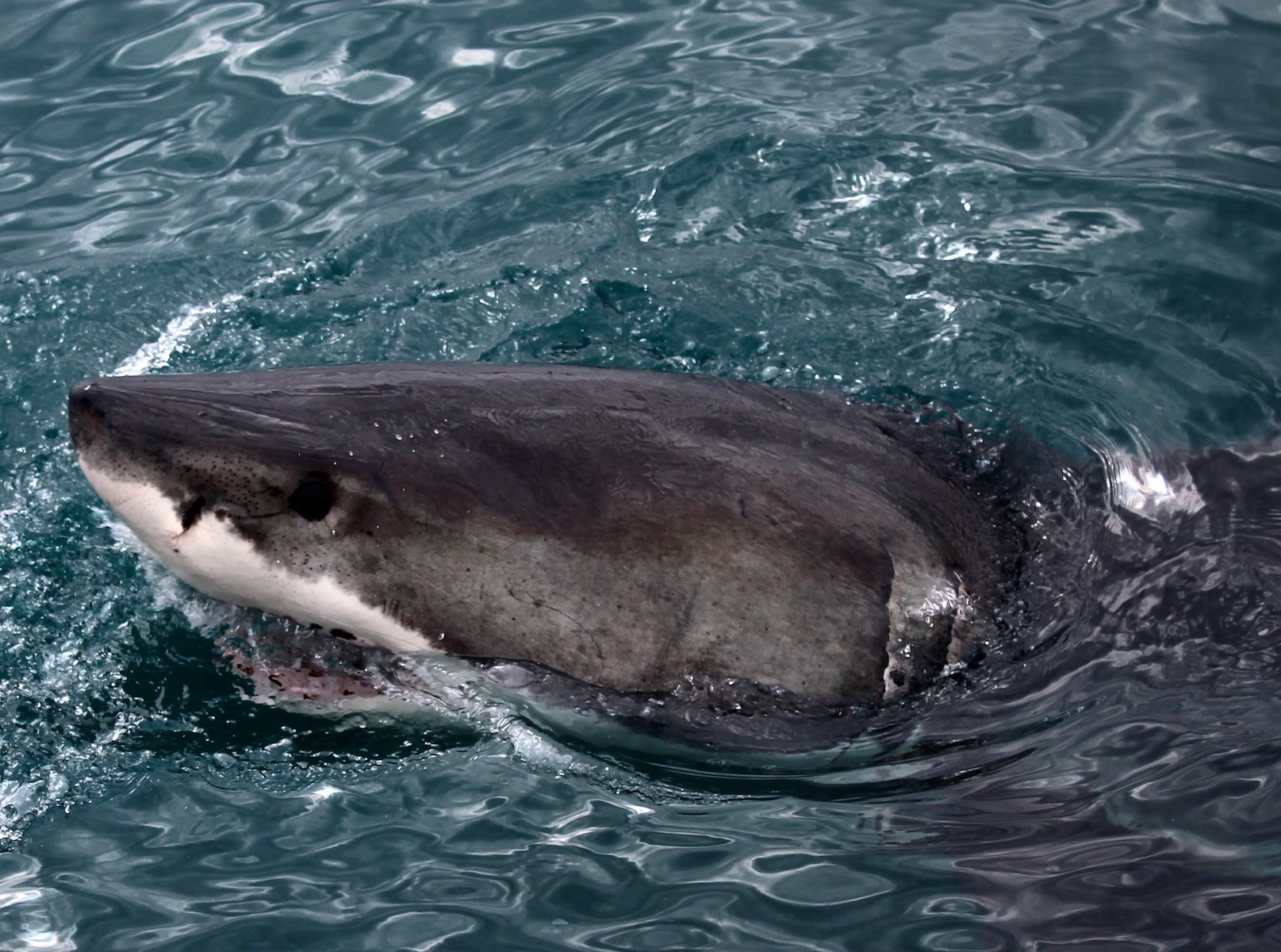
As with many forms of wildlife tourism, shark cage diving is not without its detractors. Cage diving has been criticized for desensitizing sharks and conditioning them to associate humans with food. This criticism, according to cage diving operators, is as misplaced as an exploding scuba tank in a shark’s mouth.
“The shark doesn’t say, ‘well, I stole a bait from a shark boat, therefore, I now associate food with a swimmer,’ that’s crazy,” Fallows said. “Most people who conjure up many of the misconceptions that have in the past occurred in our industry have never even been out to see sharks, let alone the way we operate. A lot of the science points to the exact opposite: sharks do not associate cage diving with people and people as food. There is no scientific evidence cage diving has led to an increase in attacks on humans.”
In short: don’t be scared to hit the Muizenberg or Camps Bay beaches when you return to Cape Town.
Conservation-minded travelers will also appreciate cage diving in Gansbaai. The cage diving industry, according to Towner, is one of the best ways to protect sharks from poachers and acts as an unofficial security force against overfishing and hunters.
“Cage diving is a USD $70 million-industry and it is one of the strongholds keeping sharks worth more alive than dead,” Towner said. “If you took cage diving away there would be no policing and you would have constant pillaging of sharks in the oceans.”
Cage diving is the big draw in Gansbaai but the town and surrounding area offer activities for those preferring to stay on land. The Fynbos Trail, a few miles north of the town, provides lush hiking trails that are not as strenuous as Table Mountain or Devil’s Peak and the Lomond Wine Estate offers 11 different wines from one of the southern-most vineyards on the African continent. Gansbaai is a much smaller town and less wealthy than some of the other towns in the Western Cape, but it offers a number of pleasing activities that won’t bite your budget.
But just as one goes to Paris for the art or Las Vegas for the gambling, sharks are the reason you visit Gansbaai. Along with the southern right whale, another recurring Gansbaai resident, the great white is part of South Africa’s “Big Five” ocean creatures, and if you go cage diving between March and September there is a good chance you will see more than five great whites. Book a charter, grab a waterproof camera and live out Shark Week in a half-day at sea.
Just watch out above.

/
 Kyle Gillis is a freelance writer and communications professional from Sterling Heights, Michigan. He’s covered a variety of topics in his journalism career and his work has appeared in the Wall Street Journal, Las Vegas Review-Journal, Washington Examiner and Nevada Journal, among other publications. His first novel, No Worries, is available for purchase on Amazon and other booksellers.
Kyle Gillis is a freelance writer and communications professional from Sterling Heights, Michigan. He’s covered a variety of topics in his journalism career and his work has appeared in the Wall Street Journal, Las Vegas Review-Journal, Washington Examiner and Nevada Journal, among other publications. His first novel, No Worries, is available for purchase on Amazon and other booksellers.
The post A Jaws-Dropping Encounter in Gansbaai appeared first on The Expeditioner Travel Site.
]]>The post Cape Town Is Beautiful, And This Video Makes It Look Even Better appeared first on The Expeditioner Travel Site.
]]>I know that it’s not exactly difficult to make South Africa’s Cape Town look beautiful, given the perpetually sunny weather and the grand landscape of the city as it sits below nearby Table Mountain. But this video from Jesse Olson perfectly captures a certain energy and look of the city that visitors sometimes have a hard time conveying to others after they’ve visited.
And other than swimming with man-eating sharks, most people get their adrenaline rush there by hang gliding or scaling table mountain, but whatever that rope bridge is at 0:32, I am sure it will help deliver whatever internal chemicals one receives when performing any sort of death-defying activity — no climbing or flying gear needed.
*
For more great travel videos like these, visit our Travel Video group at Vimeo.
By Matt Stabile

ABOUT THE AUTHOR
 Matt Stabile is the founder and Editor-in-Chief of TheExpeditioner.com. You can read his writings, watch his travel videos, purchase the book he co-edited or contact him via email at any time at TheExpeditioner.com. (@TheExpeditioner)
Matt Stabile is the founder and Editor-in-Chief of TheExpeditioner.com. You can read his writings, watch his travel videos, purchase the book he co-edited or contact him via email at any time at TheExpeditioner.com. (@TheExpeditioner)
The post Cape Town Is Beautiful, And This Video Makes It Look Even Better appeared first on The Expeditioner Travel Site.
]]>The post Living In The Face Of South Africa’s Apartheid appeared first on The Expeditioner Travel Site.
]]>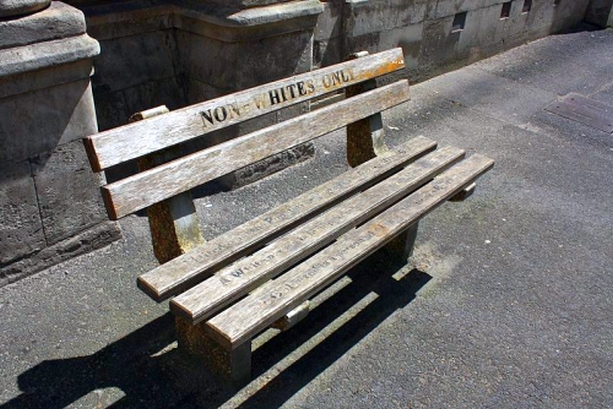
After two weeks in the bounty of Cape Town, South Africa, I can safely say I’ve arrived home.
The depths of jet-lag got me out of bed just before dawn. I’ve fired up my laptop and I find myself typing amidst a flickering orange hue of a fire to my right; my two huskies lying at my feet. If I crane my neck enough, I can see dawn chasing off the blanket of sub-zero night, just enough to backlight the jagged profile of Montana’s Tobacco Root Mountains. If I lived anywhere else, I probably wouldn’t unpack my bags.
My fingers seem to take on a life of their own, dancing across the keyboard as if they were talking to me, rather than me creating words with my fingers: “Travel is the only thing you buy that makes you richer.”
It seems as if my fingers possess a deeper knowledge of life than I do. Who knew?
When I read that quote, again and again, it begins to sink in. Traveling is sometimes reduced to ticking off destinations, getting stamps in your passport, obtaining trophies; even conquests to bring home and brag to others. To me, this defeats the entire reason to travel. To travel is to experience the world, to learn about the world and the many people we share it with. As a result — one can only hope — we learn about ourselves in the process.
These previous two weeks have been an outpouring of love and generosity from friends I thought I would never see again. In 2009, I left Korea when my teaching contract was finished. It also meant I was leaving those I had grown close to in my time there. It’s a common plight of ESL teachers and travelers alike. However, three years later, I found myself sleeping in their Cape Town loft, reunited.
This trip’s worth cannot be measured by mileage, souvenirs purchased or seeing those guidebook “must-see” sites. The value is found in the moments. The split-seconds when your heart flutters, when you’re overcome by thankfulness, the pang of insight, or when you connect with someone unexpectedly. Any trip, then, becomes memory grounded in whisps of lingering moments. It will be a fleeting fraction of real time that electrifies your cortex, returning you to the place and moment. The taste in your mouth becomes the revered wretchedness of three-year-old kimchi, the hardened earth under your feet is now flour-soft Boracay sand, or the feel of shade on a hot day takes you outside the former Race Classification Appeal Board building on Queen Victoria Street in Cape Town.

Cape Town is one of the few cities on earth founded by a company, rather than “discovered” and claimed by a country. The Dutch East India Company established the colony as a refueling point along the sailing route around the southern tip of Africa. Cape Town started as a large scale farm — the Company Gardens — which restocked the ships docked in the waters of Table Bay. Soon, the company began enslaving people from Indonesia and Madagascar to meet the demand of the quickly growing colony. Slavery was established.
Of course, I didn’t know any of that before taking an impromptu walking tour of downtown Cape Town. Generally speaking, a walking tour of a town, any town, won’t be one of those incredible, awe-inspiring stories that transports you back decades later. Lucky for us, a good friend of our hosts, a successful guide in his own right, volunteered a day of his weekend to show us around. It was a wonderful gift. From the Castle of Good Hope to District Six, we heard the good, the bad and the heartbreaking events that occurred within a few square blocks of downtown.
We strolled passed a brightly painted Dutch-style building, one of the oldest in Cape Town, now the Iziko Slave Lodge. The building is a museum that exposes its original purpose: housing slaves before they were to be sold.
Down the block from the slave lodge stands a rather ordinary stone building. Bookended by generic ’70s modular architecture, the building gave off a former-governmental-structure vibe. Any other day I would have wandered right on by without giving a whisper of thought. On this day, that building became the moment.
The grey blocks making up the exterior were shaded and weathered, just another old building blending in with modern city life. We stopped in front of it, next to a bench and nearby plaque. I began to read:
In the 1960’s, a room in this building was the scene of formal hearings of the most bizarre and humiliating kind as ordinary people came before an appeal panel to argue about what “race” they should be labeled. Between 1950 and 1991, apartheid’s Population Registration Act classified every South African as belonging to one of seven”races” — and accordingly granted or denied them citizenship rights on a sliding scale from White (full rights) to Bantu (with the fewest). The classification was subjective and families were split apart when paler or darker skinned children or parents or those with curlier hair, or different features were placed in separate categories.
I looked closer at the bench and brushed away some dust: Whites Only. Perhaps six feet away, on the other side of the building’s entrance, was another bench: Non-Whites Only. Apartheid suddenly blindsided me; a heavy weight on my chest. It became real.
I could tell my wife’s realization, similar to mine. We looked at each other, our skin extra pale from the northern hemisphere winter, then to the group — all with deep-hued skin tones. It was just 21 years ago that we would have been forced to sit apart; forced to live separately. The quiet of realization rang like a gong inside my head. This was their life. Aside from their accents and superior style of clothes, the difference in our skin color hadn’t even entered my mind until now.
The moment.
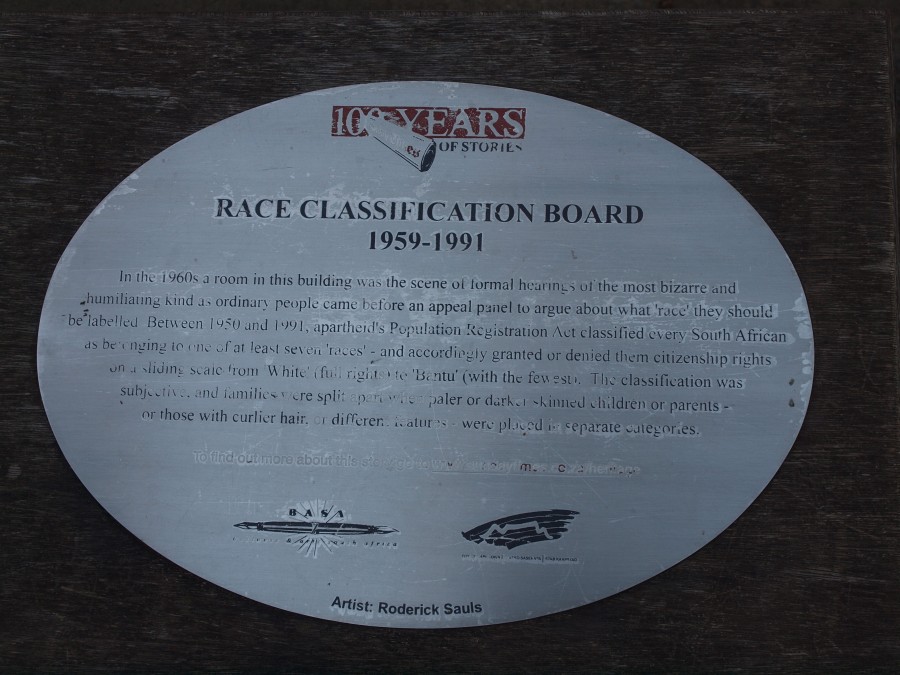
Apartheid was the official policy of racial segregation practiced by South Africa’s government that included rigid political, legal and economic discrimination against non-whites. This officially came to an end in 1992, a mere 21 years ago. This discrimination has touched everyone I shared the sidewalk with. It has touched our friends’ lives. In many ways, this still is our lives.
I attempted to wrap my mind around it: If, by chance, I had met these people I have come to love while we were in junior high school, it couldn’t have happened — wouldn’t have happened. How have such generous, giving and thoughtful people escaped such evil to become beacons of light. Why don’t they hate me? The only possible answer is love and kindness. Sharing of love and kindness is more powerful than anything in the world.
My heart broke, and still does, for an entire people. Yet, simultaneously, I am comforted that our world, for the most part, is heading in a better direction.
I can easily say life would not be nearly as rich nor as beautiful without my Cape Town family. For two weeks, everyone there gave us so much of themselves, their time and their grace. They invited us into their homes, cooked and shared stories. Our friends are love, they are all that is good within the Rainbow Country.
Yes, we are different and that’s okay. In fact, that’s great. It makes the rainbow all that more beautiful. I really am the richest person in the world.
By Jon Wick
[Non-Whites Only Bench by KNewman1/Wikipedia]

About the Author
 Jon lives in Butte, Montana, teaching in the Technical Communication department of Montana Tech and moonlighting as the owner of 5518 Designs. Between work, play, and his recent adventure into roasting coffee, Jon squeezes in family time on the trails with his wife Cassie and pair of huskies. Catch more of Jon at TheJonWickProject.wordpress.com. (@ExpedJon)
Jon lives in Butte, Montana, teaching in the Technical Communication department of Montana Tech and moonlighting as the owner of 5518 Designs. Between work, play, and his recent adventure into roasting coffee, Jon squeezes in family time on the trails with his wife Cassie and pair of huskies. Catch more of Jon at TheJonWickProject.wordpress.com. (@ExpedJon)
The post Living In The Face Of South Africa’s Apartheid appeared first on The Expeditioner Travel Site.
]]>The post Taking A 350-Foot Plunge Into A Stadium [Video] appeared first on The Expeditioner Travel Site.
]]>If you find yourself in Durban, South Africa, and are looking to try to induce your very own coronary while on vacation, head over to the Moses Mabhida Stadium and try out the “Big Rush Big Swing,” a 350-foot-high bungee swing that catapults you across the entire football pitch at bowel-releasing speeds.
The above video was taken by travel bloggers Positive World Travel during their “swing” (sorry) through South Africa.
[Postive World Travel YouTube Channel]
By Matt Stabile

ABOUT THE AUTHOR
 Matt Stabile is the Founder and Editor-in-Chief of The Expeditioner. The Expeditioner began in 2008 and is headquartered in New York City. You can read his writings, watch his travel videos or contact him at any time at TheExpeditioner.com. (@TheExpeditioner)
Matt Stabile is the Founder and Editor-in-Chief of The Expeditioner. The Expeditioner began in 2008 and is headquartered in New York City. You can read his writings, watch his travel videos or contact him at any time at TheExpeditioner.com. (@TheExpeditioner)
The post Taking A 350-Foot Plunge Into A Stadium [Video] appeared first on The Expeditioner Travel Site.
]]>The post What It’s Like The First Time You Spot A Lion In Africa appeared first on The Expeditioner Travel Site.
]]>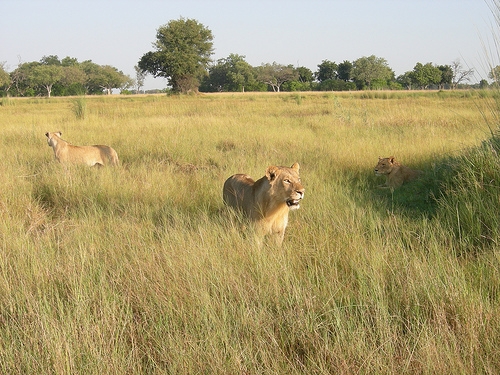
One of the sad parts about going on safari is the speed at which you become desensitized to what would otherwise be an incredible viewing experience anywhere else in the world. For example, during my own mini-safari in South Africa’s Kruger National Park, the first animal my small group encountered was a small gathering of impala — a medium-sized antelope originating from the continent of Africa. All of us clambered to the edge of the vehicle with cameras in tow to capture their image for the next 10 minutes while our driver sleepily slunk into his chair, enjoying a few moments of rest during this ungodly early hour of the morning.
What he knew, and what we’d find out soon enough, is that the impala in Kruger is what the pigeon is to New York City. In other words, not much to get worked up about, as we were about to encounter impala basically everywhere we went, including our campsite, during our game drives, near the restaurant where we would have lunch and pretty much anywhere else we went in search of other animals.
However, of the other animals we encountered — giraffes, wildebeests, cape buffalos, grey and white rhinos, elephants, bats, hyenas — the one animal we nor anyone else I knew never got tired of seeing was the lion. In fact, one finds that much of their day is spent in search of lions, with guides radioing each other as to their last sighting, park maps with magnetic markers indicating recent viewings, and even the occasional traffic jam as multiple vehicles bottleneck on the same narrow roadway as a lion or two is spotted.
The Sydney Morning Herald recently went on safari to Botswana’s Okavango Delta, a region famed for its wildlife offerings. Undoubtedly, the delta is one of the premier spots in Africa to go on safari.
Unlike some of its neighbours, Botswana has pursued a low-impact, high-cost approach to tourism. The Okavango Delta operates like a big nature reserve. There are about 60-odd camps in the 17,000-square-kilometre area and any safari operator who obtains a permit is only allowed to build semi-permanent structures that can be dismantled in a day or two.
In Africa, water equals animals, so naturally the Okavango Delta is a premier spot to see all sorts of wildlife. And like true love and one’s first encounter with the Shamrock Shake, your first encounter with a lion is truly a memorable experience, as the author recounts. “The spell that seemed to come over me during the encounter is broken. I breathe easily again. This is my first meeting with the king of the jungle in the wild and although it lasts only a few minutes, I am overwhelmed. I am in Africa, I am in the midst of nature’s stunning creations, and I feel alive in a way I have never felt before.”
My own encounter included a mother with six cubs whom we ran into every day in the morning as she led her cubs on morning hunts. Sadly enough, by the last day, the number of her cubs had been reduced to five, with no indication of what happened to the sixth sibling. Heartbreaking, yes, but this is Africa in its truest form.
[Okavango Delta by Joachim Huber/Flickr]
The post What It’s Like The First Time You Spot A Lion In Africa appeared first on The Expeditioner Travel Site.
]]>The post Diving With Dinosaurs In South Africa appeared first on The Expeditioner Travel Site.
]]>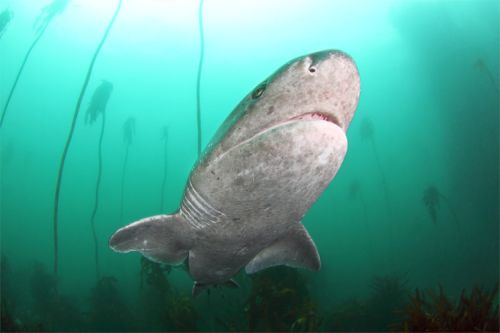
Just off the Cape Peninsula and south of Cape Town in South Africa, lies an innocuous short stretch of ocean. Like much of the seascape here, kelp sprouts from the kryptonite green water, which laps at boulders straight out of The Flintstones. It looks a lot like the rest of this spectacular coastline. Yet this body of water harbors a prehistoric secret: Just a short hop, skip and a dive away from the shore swim living, breathing dinosaurs.
The name of these astonishing creatures is the broadnose sevengill shark. Yet I prefer their more palatable, less adjective heavy name: cow shark. These fish have glided through our oceans for hundreds of million of years, unblemished by Mother Nature’s marauding fingers. All sharks originally possessed seven pairs of gill slits. A period of tweaking and refining commenced and most species drop a couple of pairs. For some reason the cow sharks kept theirs. In fact, cow sharks have very few modern adaptations, which is why they remain one of the closest links we have to dinosaurs on earth.
For some unknown reason, the cow sharks just love this tiny stretch of water and congregate here en masse, just meters offshore. I’d read about this extraordinary site, yet before now had never had the opportunity to dive here. Shore diving remains one of my favorite methods of exploring the deep blue; there are no boats with their thumping motors, no launches, no traveling out for miles to sea. A shore dive simply features you, your breathing apparatus, your buddies and a gradual descent into an underwater world packed full of goodies.
Unfortunately, these goodies come wrapped in a bitterly cold packaging. Even 10mm of neoprene, hoodies, gloves and boots do little to mask the freezing water here. Our dive guide was free diver and photographer Jacques de Vos. Jacques has spent countless hours underwater interacting with the cow sharks, and has built up an intimate knowledge of their behavior and habits. He stressed that while the cow sharks may appear docile, we must maintain eye contact and not touch them. Attacks on divers are rare, yet it’s important to remain vigilant when dealing with toothy predators like sharks — especially ones that can grow to 13 feet in length and have been found with human remains in their stomachs.
Jacques, divemaster Rob, myself and my colleague — though the local diver center Pisces Divers — entered the water via the rocks. The Cape’s waters welcomed us with an icy blast, jolting our systems, priming our senses. During descents into unfamiliar (and shark-infested) territories, I frequently remind myself that each year more people are killed by their Christmas tree lights, or by falling off their chairs than by sharks. However, it’s easy to lose sight of such rational thoughts in these famously murky waters.
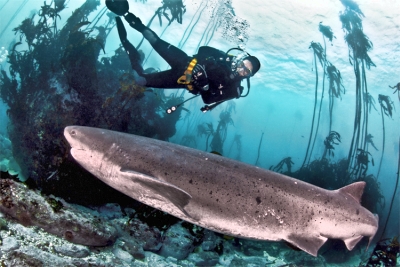 My mind turned to the ridicule that would ensue at being chomped by a shark named after a chubby, milk-yielding herbivore. I’d never live it down. Thankfully, the chances of being nibbled by a cow shark remain minuscule. My first encounter with a six-foot-long male put me at ease. In fact, I could have sworn it was smiling at me. Much like dolphins, cow sharks’ stubby faces are etched with perma-smiles. Depending on your point of view, this is either quite cute or freakishly sinister. Either way, it’s as unusual as it is mesmerising.
My mind turned to the ridicule that would ensue at being chomped by a shark named after a chubby, milk-yielding herbivore. I’d never live it down. Thankfully, the chances of being nibbled by a cow shark remain minuscule. My first encounter with a six-foot-long male put me at ease. In fact, I could have sworn it was smiling at me. Much like dolphins, cow sharks’ stubby faces are etched with perma-smiles. Depending on your point of view, this is either quite cute or freakishly sinister. Either way, it’s as unusual as it is mesmerising.
The other notable thing about these sharks is their curious, bold nature. Most sharks, despite their fearsome reputations, remain skittish when encountering humans. Cow sharks, on the other hand, will boldly check divers out, flash a wicked smile and then glide off momentarily, before returning for a second look. They move as if in slow motion, their stout bodies propelled by long, elegant sweeps of the tail. The sharks are a photographer’s dream; willing posers for the camera, unfazed by the flashes of strobes and enveloped by the most spectacular studio imaginable.
Sadly, the fate of the cow sharks may remain a familiar one. They are being fished extensively in these waters. While I was there, reports began to surface of cow sharks being used as bait for great whites by several of the operators in nearby Gansbaai.
Sharks are yet again falling prey to the greatest predator to ever walk the earth: man. Every year, we are responsible for the deaths of up to 100 million sharks. We kill sharks for their jaws and teeth which make tacky souvenirs. We kill them for the oil in their liver, their cartilage, flesh and fins. Now, unimaginably, we are killing them to feed to their own, by those who pass themselves off as shark conservationists.
I left this magical stretch of water full of wonder at the amazing smiling cow sharks of Cape Town, yet appalled at how, once again, we are changing the face of our oceans. Cow sharks have survived five mass extinctions and due to Man’s short sightedness and greed, they now face a sixth.
By Aaron Gekosk

About the Author
 Aaron Gekoski is a freelance photojournalist and filmmaker. His work appears regularly in National Geographic Traveller, Go!, Men’s Health, FHM, Africa Geographic and many more publications around the world. Last year, Aaron was part of a team that shot Shiver, a documentary on Africa’s shark finning crisis. For more information, please visit AaronGekoski.com.
Aaron Gekoski is a freelance photojournalist and filmmaker. His work appears regularly in National Geographic Traveller, Go!, Men’s Health, FHM, Africa Geographic and many more publications around the world. Last year, Aaron was part of a team that shot Shiver, a documentary on Africa’s shark finning crisis. For more information, please visit AaronGekoski.com.
The post Diving With Dinosaurs In South Africa appeared first on The Expeditioner Travel Site.
]]>The post When In South Africa, Go To Mozambique appeared first on The Expeditioner Travel Site.
]]>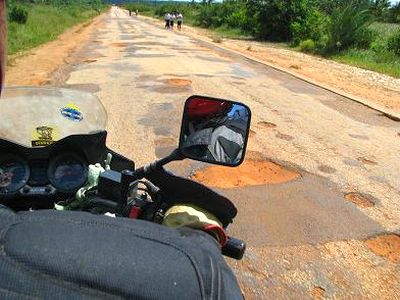
It’s a horrible analogy, but here it goes. Mozambique is to South Africa as Mexico is to the U.S.: Respites away from the home country where the currency goes further, the beaches go less visited, and the chance to get far away from it all is really not that far away at all.
This week the FT travels to Mozambique in an effort to highlight the attractions that World Cup goers can look forward to — especially with time to spare once their team is eliminated — when heading out of South Africa. As they point out, the ‘Bique (no one calls the country that by the way, but when they do, remember you heard it here first) is only a short plane ride or a few-hour car trip from most of the bigger cities in South Africa.
In fact, from personal experience, a road trip is highly encouraged. Heading south from the city of Nelspruit (the popular gateway to Kruger National Park), you can drive though the wooded highlands of Eastern South Africa, through scenic Swaziland, and be in the capital city of Maputo all in a day’s drive. From there, well, South Africa will likely be a distant memory, as well as your team’s loss.
The post When In South Africa, Go To Mozambique appeared first on The Expeditioner Travel Site.
]]>The post Escape The Crowds At The 2010 World Cup appeared first on The Expeditioner Travel Site.
]]>
I’ve come down with football fever and it might be from all the pre-World Cup coverage that is going on. Countries and companies across the world are promoting their teams everywhere from YouTube tonormal tube. There have been whole segments on the radio dedicated to soccer balls and fancy shoes.
An article in The Wall Street Journal predicts South Africa will host over 300,000 visitors for the games. My guess is things are going to get tight. Luckily, the article also points out spots to escape the frenzy, like the vineyards in Vergelegen.
Perhaps one would prefer to stay in Woodstock, Cape Town, one of the only communities in the city that avoided Apartheid, as recommended in an article in The New York Times.
Once an impoverished community — a “place you would come to get drugs” as a local Ms. Dudley explains — it is now thriving with art and delicacies. It boasts organic products at its Saturday Neighborhoods Market, and travelers can gander at the displays of prints at the South African Print Gallery.
Need some love? Ms. Dudley’s got a shop that slips a little Love Potion into the sandwiches (curiously a “garlicky dressing”.)
The World Cup. I couldn’t fathom the energy and excitement, nor the exhaustion that could ensue. Taking a break over a bottle of Syrah and a Love Sandwich might not be a bad idea.
By Brit Weaver

About the Author

Toronto born and based, Brit is an avid leisure cyclist, coffee drinker and under-a-tree park-ist. She often finds herself meandering foreign cities looking for street eats to nibble, trees to climb, a patch of grass to sit on, or a small bookstore to sift through. You can find her musing life on her personal blog, TheBubblesAreDead.wordpress.com.
The post Escape The Crowds At The 2010 World Cup appeared first on The Expeditioner Travel Site.
]]>The post Why You Need To Visit Soweto When In Jo-Burg appeared first on The Expeditioner Travel Site.
]]>
No offense to the city of Johannesburg, but one thing you hear over and over when you’re traveling in South Africa is, “Fly in and leave, there’s nothing to do there.” Of course this is a bit of an exaggeration, but it is hard for the city to live up to the high expectations of travelers, what with everything else they’re seeing and doing while in the region. But if you do happen to find yourself in the city for more than a day or two, there’s probably nothing better you can do than take a trip to Soweto.
A short drive southwest from Johannesburg — the area’s name is short for South Western Township — there are many guides that will pick you up from your hostel or hotel and show you around the now very diverse township. The area was formed as a result of the influx of African workers looking for cheap housing at the end of the 19th-century, and grew to become a potent symbol of apartheid as black Africans were relocated there during the apartheid era.
As the NZ Herald explores, though apartheid is long gone, the area is still home to some of the worst living conditions and poorest of the population. However, as I learned while touring it, there is also a strong undercurrent of hope that pervades the area, with strong middle-class neighborhoods sprouting up, and even a high-end mall that Johannesburg is, unfortunately, so well known for.
If you go, don’t miss seeing Winnie Mandela’s and Desmond Tutu’s homes, the Hector Pieterson Memorial Museum (pictured above), and Wandie’s Place, one of the city’s most famous restaurants, and whose site boasts that both Quincy Jones and Evander Holyfield have eaten there. You had me at Quincy Jones.
The post Why You Need To Visit Soweto When In Jo-Burg appeared first on The Expeditioner Travel Site.
]]>The post Bring On The Footie! A World Cup Guide appeared first on The Expeditioner Travel Site.
]]>
With neverending controversy and nearly everyone in Vegas betting on its failure, the World Cup is set and ready to roll. If you are lucky enough to get your hands on some tickets, know that we will be watching for you on TV, and wishing we were there too.
To put some finishing details on your trip to South Africa, BootsnAll has recently released a quality guide to the games to help you out. From complete guides on each of the nine host cities, to venue information, traveling tips, accommodation, an educated word on the travel risks, and possibly the most important guide of them all, the after-parties. Plus, it has links to all sorts of information, including a full match schedule.
One thing neglected on this page—how to paint your face like a true soccer fan. Bring on the footie!
The post Bring On The Footie! A World Cup Guide appeared first on The Expeditioner Travel Site.
]]>The post Travel Guide To A South African Safari appeared first on The Expeditioner Travel Site.
]]>On the way, my crew and I cruise the African bush in a converted Land Rover, stop at frightening Lake Panic, and have lunch with a few hundred bats at Skukuza restcamp, You know, typical safari stuff.
The post Travel Guide To A South African Safari appeared first on The Expeditioner Travel Site.
]]>The post Images Of Africa appeared first on The Expeditioner Travel Site.
]]>These images are from my trip through South African and Mozambique during September, 2009.











MOZAMBIQUE






The post Images Of Africa appeared first on The Expeditioner Travel Site.
]]>The post Top Three Spots For Do-It-Yourself Safaris appeared first on The Expeditioner Travel Site.
]]>
With over 21 public reserves within its borders (not to mention the scores of others located in bordering Mozambique and Botswana), safariing in South Africa can be both accessible and affordable, you just need to know where to go.
The Sydney Morning Herald names their three top spots for game-watching and nature-gawking on the cheap.
1) Kruger: Home to the Big Five, Kruger is by far the country’s biggest park and has 12 camps spread about for you to crash in after a long day of hippo-watching. (That should be their motto, what do you think?)
2) Addo Elephant National Park: One of the only parks in the country where you have the chance to glimpse southern right whales and great white sharks, tents can be had in this Eastern Cape preserve.
3) Kgalagadi Transfrontier Park: Emsbok (a big desert antelope) can be seen in this park located in the Kalahari; cabins running on solar energy are only natural in this desert outpost.
The post Top Three Spots For Do-It-Yourself Safaris appeared first on The Expeditioner Travel Site.
]]>The post So You Think You Know South Africa? appeared first on The Expeditioner Travel Site.
]]>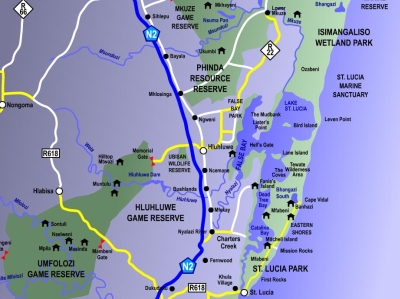
Kruger may be better known, but South Africa’s iSimangaliso Wetland Park has its fair share of wildlife, including hippos, Zambezi sharks, crocodiles, antelope, and over 500 species of birds.
Located in the northeastern part of the country, just south of Mozambique, iSimangaliso boasts five ecosystems and can safely be described as “South Africa’s answer to the Great Barrier Reef.” I get the sense that visiting here would be something like spring break for “Planet Earth” fans.
The post So You Think You Know South Africa? appeared first on The Expeditioner Travel Site.
]]>The post Top 8 Ways To See Cape Town Through A Different Lens appeared first on The Expeditioner Travel Site.
]]>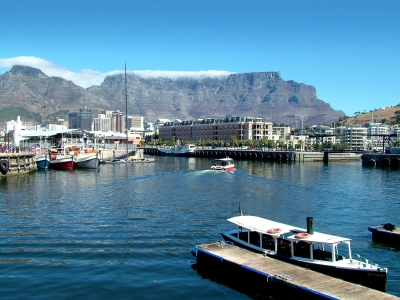
If you’re looking for a way to get away from the madding crowds in Cape Town, try these 8 alternative ways to see the city through a different lens.
By Lucy Corne
Cape Town is one of those places that everyone should visit in their lifetime. It has everything: natural beauty, a vibrant cocktail of cultures, belt-expanding food and wonderfully welcoming people. Many attractions have reputations that precede them — I’d heard of the Cape of Good Hope and Robben Island before I had any idea what or where they were — but what if you want to step off the beaten track? The main attractions are undeniably outstanding, but when the swarms of tourists get too much, you might want to seek out a quieter way to enjoy the “Mother City.” Here are eight alternatives to the tour bus favorites.
1) Follow the crowds: Take the cable car up Table Mountain
An original take: Hike to the top of Lion’s Head
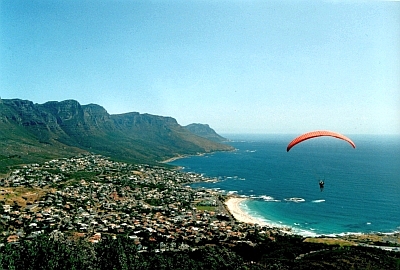 Table Mountain tops most people’s list of things to do in Cape Town, but there are more options than just jumping on the revolving cableway to reach the mountain’s flat top. You could join the energetic travelers who hike to the 1,086-meter summit or, for a less congested hike, opt to scale nearby Lion’s Head. It’s a challenging hike that takes in narrow paths, steep drops and occasionally has you grasping on to chains to haul yourself up the rocks. Still it’s all worth it for the stunning views — in my opinion far superior to the vistas from the top of Table Mountain. Of course, since Lion’s Head is just a couple of kilometers away from the mountain, the panoramas are similar: ocean views and the city laid out beneath you. But seen from Lion’s Head you get an added bonus, Table Mountain is part of the view as well. If clambering to the top is not thrilling enough for you, book a paragliding tour and take the more adventurous route back to sea level.
Table Mountain tops most people’s list of things to do in Cape Town, but there are more options than just jumping on the revolving cableway to reach the mountain’s flat top. You could join the energetic travelers who hike to the 1,086-meter summit or, for a less congested hike, opt to scale nearby Lion’s Head. It’s a challenging hike that takes in narrow paths, steep drops and occasionally has you grasping on to chains to haul yourself up the rocks. Still it’s all worth it for the stunning views — in my opinion far superior to the vistas from the top of Table Mountain. Of course, since Lion’s Head is just a couple of kilometers away from the mountain, the panoramas are similar: ocean views and the city laid out beneath you. But seen from Lion’s Head you get an added bonus, Table Mountain is part of the view as well. If clambering to the top is not thrilling enough for you, book a paragliding tour and take the more adventurous route back to sea level.
2) Follow the crowds: Sip wine in picture-perfect Constantia
An original take: Down beer at the SAB Brewery in Newlands
South Africa is often associated with wine, but you don’t have to spend long in the country to realize that you’re in a nation of beer lovers. The Ohlsson’s Brewery in Newlands might lack the aesthetic value of the Constantia winelands just south of the city, but the informative tour through a fully functioning brewery makes up for the lack of prettiness. And of course, once the hour-long tour ends, the fun really begins as you’re left in the on-site pub to taste SAB’s many different brews.
3) Follow the crowds: Paddle with penguins in Simon’s Town
An original take: Take a boat to see seals near Fish Hoek
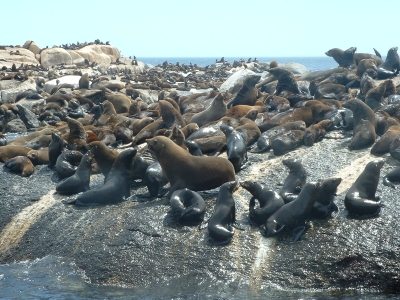 There aren’t many places where you can paddle in a boat amongst penguins, and I wouldn’t for a second suggest that you miss out on Boulder’s Beach and its colony of African Penguins, but there are other notable wildlife encounters around Cape Town. Jump on one of the regular boats from Fish Hoek’s harbor and visit the small colony of Cape Fur Seals lounging on an island a couple of bays away. Be prepared for the overwhelming stench; they might look cute, but they smell like rotting fish. The choppy boats also take in a shipwreck before heading back to Fish Hoek’s stunning beach. Those who don’t mind venturing a little further should head to the real Seal Island in False Bay. There are hundreds of seals here and the waters are a favorite lunch stop for Great White Sharks.
There aren’t many places where you can paddle in a boat amongst penguins, and I wouldn’t for a second suggest that you miss out on Boulder’s Beach and its colony of African Penguins, but there are other notable wildlife encounters around Cape Town. Jump on one of the regular boats from Fish Hoek’s harbor and visit the small colony of Cape Fur Seals lounging on an island a couple of bays away. Be prepared for the overwhelming stench; they might look cute, but they smell like rotting fish. The choppy boats also take in a shipwreck before heading back to Fish Hoek’s stunning beach. Those who don’t mind venturing a little further should head to the real Seal Island in False Bay. There are hundreds of seals here and the waters are a favorite lunch stop for Great White Sharks.
4) Follow the crowds: Follow the Long Walk to Freedom on Robben Island
An original take: Follow in the footsteps of the San at !Khwa ttu
Okay, in truth there really is no substitute for the moving trip to Robben Island, home to the prison that held Nelson Mandela for 18 of his 27 years of incarceration. But once you’ve taken the choppy ferry over to the former prison and leper colony you might like to consider stepping a little further back in time to explore !Khwa ttu, a cultural center dedicated to the San, South Africa’s earliest dwellers. San descendants offer an insight into this forgotten culture and a quick lesson in their bizarre-sounding but delightful “clicking” language. The center is 70 kilometers north of Cape Town, near Yzerfontein.
5) Follow the crowds: Enjoy a relaxing picnic at the Kirstenbosch Botanical Gardens
An original take: Work for your lunch with a hike through the Kogelberg Nature Reserve
With its manicured lawns and dramatic mountain backdrop, Kirstenbosch is certainly beautiful and a great place to stroll, but if your trip to Cape Town is brief why not opt for a more challenging outdoor experience? The craggy mountain scenery is echoed at Kogelberg, but visitor numbers are limited, meaning you get a quieter, less polished encounter. The rugged terrain makes for wonderful hikes where you might spot small antelope, baboons, eagles and the locally famous herd of horses descended from those abandoned here after the Anglo-Boer War.
6) Follow the crowds: Chain stores and lunch at the V&A Waterfront
An original take: Haggling and lunch on Long Street
The Waterfront is one of Cape Town’s favorite attractions and its pedestrian-friendly complex of shops, cafes, bars and restaurants is definitely worth a visit. But prices here can be steep, and while undoubtedly pretty, the Waterfront lacks character. For a more vibrant buying and dining experience, head to Long Street, the heart and soul of central Cape Town. Shop for quirky souvenirs in the African Bead Store, lunch on local dishes or gourmet sandwiches in the hip cafes and end with a haggle in the Pan-African Market or Greenmarket Square — great places to pick up six-feet tall giraffes, township art crafted from trash and scary but perfectly-carved masks.
7) Follow the crowds: Have an emotional encounter at the District Six Museum
An original take: Have an emotional encounter at Lwandle’s Migrant Labour Museum
Visiting the District Six Museum is an utterly moving experience. It recounts one of the most hated policies of the apartheid regime: the forced removal of families from their homes across the country as regions were designated “white only.” The museum is excellent and never fails to have you reaching for your hankie, but sometimes the endless stream of tour groups can detract from the poignancy of the exhibits. If you have a rental car and feel like supporting a project in need, head east of the city to Lwandle, a township near Somerset West. After visiting the deserted but excellently laid-out museum, staff will take you on a walking tour to visit the former hostels — depressing boarding houses built for migrant workers who were forced to leave their families behind as they searched for work in the cities.
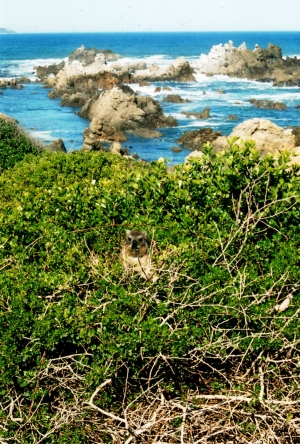 8) Follow the crowds: Get snap-happy at the Cape of Good Hope and Cape Point
8) Follow the crowds: Get snap-happy at the Cape of Good Hope and Cape Point
An original take: Head to the real “end of the world” at Cape Agulhas
It’s a common misconception: Crowds of tourists descend daily on the Cape of Good Hope, intent on visiting the southernmost tip of Africa and snapping a few shots of the Atlantic and Indian Oceans meeting offshore. Sadly, neither of these things is possible here. Stunning views are a given, as are hordes of tourists and a few rogue baboons stealing people’s picnics, but the real “end of the world” is actually 200 kilometers east of Cape Town. Cape Agulhas can’t compete with Cape Point’s dramatic scenery, but it certainly holds the trump card in tranquility. There’s not a lot here other than a very photogenic lighthouse, a shipwreck and a far less-photographed sign than the one found at the Cape of Good Hope, but if you’re the kind of traveler who likes superlatives, silence or photos of significant signs, then it’s definitely worth the trek.

The post Top 8 Ways To See Cape Town Through A Different Lens appeared first on The Expeditioner Travel Site.
]]>The post Kruger: The World’s Best National Park? appeared first on The Expeditioner Travel Site.
]]>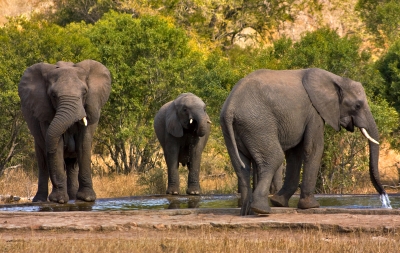
Kruger National Park, the massive, 7,332-square-mile reserve in northeastern South Africa, is home to 517 species of birds and 147 species of mammals, including the Big Five (lion, leopard, buffalo, elephant and the rhino).
The best part? Don’t expect Kruger to be some sort of South Africa-Disneyland: “Kruger is not a glorified tourist trap, but a classical conservation showcase – there has been no need to invent Disney-type cartoon-mouse attractions here. Within its fences, ecosystems function much as they always have, with a little human tinkering here and there.”
No offense Yellowstone, but last time I was there I saw some geysers and a couple of buffalo. You’re going to have to do a little better than that to compete with Kruger. (Yes, I understand, this is not a competition.)
According to the park’s official site, the best time to go is surprisingly enough, during their winter (July to September): “This period is very dry in the bush with very cold night temperatures and therefore chilly during the early morning and late afternoon game drives. Game viewing is generally fantastic as the visibility is good and the game is concentrated around any water source.”
For a chance to really get away, there’s even some job openings there. And you thought your time spent in your cubicle was exciting.
The post Kruger: The World’s Best National Park? appeared first on The Expeditioner Travel Site.
]]>The post How To Find Rhino In South Africa’s Phinda Reserve appeared first on The Expeditioner Travel Site.
]]>
Nestled against the eastern coastline of South Africa is Phinda Resource Reserve, a 57,000-acre reserve boasting the Big Five, 380 bird species and a coastline teeming with marine life.
The Independent Online has a great story of one woman’s trek into the bush to track down and catch a peek of one of the 50 rhinos that roam these grasslands. Apparently, to track rhino means you must be comfortable with both touching and smelling their feces, which is why I would probably never make it as a safari guide.
The post How To Find Rhino In South Africa’s Phinda Reserve appeared first on The Expeditioner Travel Site.
]]>The post Cape Town For Free? appeared first on The Expeditioner Travel Site.
]]>
It’s South Africa, so everything about a trip there must be expensive, right? Wrong. I’m on the South African Airlines e-mail list, and every month there’s a new deal for flights from North America (New York/Washington) to Cape Town or Johannesburg for a little over US$1,000.00. You can sign up here.
If you’re heading to Cape Town (which is consistently ranked near the top of the Top 10 Cities in the world) there’s a ton of free places to see and things to do. Like most cities, if you visit during certain times of the year the museums are open to the public for free. (Museums in Cape Town vary from the National Gallery to galleries featuring contempory works.)
Cape Town’s most prominent landmark is of course Table Mountain, which is also home to the city’s largest national park boasting miles of trails (offering some of the best views of the city) which are free to the public.
For more tips on visiting Cape Town on the cheap check out this article.
The post Cape Town For Free? appeared first on The Expeditioner Travel Site.
]]>The post Top 10 Undiscovered Travel Spots appeared first on The Expeditioner Travel Site.
]]>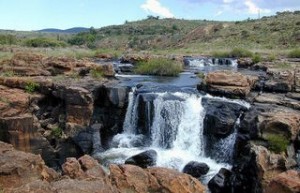
Budget Travel came out with their 2008 list of the top 10 “new” places to visit this year which, by “new,” I think they mean “not overrun by tourists yet” rather than physical age. (I have a feeling Bergerac, France is probably not that new.) Here are a few highlights.
? Trying to get off-the-beaten-path in South Africa? Skip Cape Town and Johannesburg and explore
Graskop, the Berkeley of
South Africa. Just four hours from Johannesburg, this artist-friendly hamlet is home to an outdoorsy population which thrives on some of the best views in the country.
? Kick back and relax in the famed hot springs of Tanabe, Japan, and explore unblemished Japan at its best.
? Bypass Bordeaux and head to Bergerac, France, for some of the region’s best wines and exquisite meals. There’s also some sort of tobacco museum there, which Wikipedia so elegantly includes
in its city description with this:
“Bergerac . . .features a tobacco museum, at which no smoking is allowed.” I’ll stick to the wine, thank you.
The post Top 10 Undiscovered Travel Spots appeared first on The Expeditioner Travel Site.
]]>